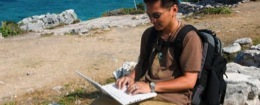 |
 |
| View the site |
HP
Labs' mscapers.com |
 |
 |
| Background |
HP Labs has a revolutionary new technology for smartphones
and GPS devices. Called mediascapes, they're games, guides, and stories
— full of music, graphics, video, and animation — triggered
by your GPS location. |
 |
Mscapers.com — HP Labs' site devoted to
mediascapes — had grown cluttered since its launch in early 2007,
evolving into a grab-bag of attempts to get the message across — none
of which entirely succeeded. The process of downloading the toolkit and
player had become similarly convoluted, growing into an amalgam of ad-hoc
attempts to solve various problems that had never been integrated into a
coherent whole. |
 |
 |
| The Project |
Focused the messaging. Revamped
the content. Describing mediascapes and the Mscape technology succinctly
was the principle challenge in making the site work. |
| |
I spent time with the team exploring with them the essence
of the message they wanted to communicate. I focused and clarified the messaging,
and I created a tag line for the site. |
| |
Since the target audience was primarily game developers,
tone was important. It had to be anything but corporate. I cast the messaging
in language that was concise, energetic, and had a bit of attitude. |
| |
I stripped the content on each page of clutter and pared
it down to the facts that addressed users' needs. I enlivened concepts
unfamiliar to users with media from actual mediascapes — to make
theory concrete. To make developing the content more efficient, I built
a wiki where I defined the purpose of every page and outlined the content
needed to achieve that end. Before I started to write the content for
a page, I'd review the specs for the page with the team to make sure we
agreed on its focus. |
| |
The result was a straightforward development and review process
that wasted no time on revision cycles. |
 |
 |
| |
Re-architected the site. Streamlined
the flow. I restructured the home page so that it focused on users'
three key tasks: learning about the technology, downloading the toolkit,
and creating a mediascape. |
| |
Of the three tasks, downloading the toolkit was the most
involved. There were different paths for different users — for developers,
for players, for Windows users, for Mac users, and so on. I revised the
flow so that it was simple, direct, and so each path had as few steps as
possible. I created signage so that it as easy for users to find their path.
I promoted the notion that the site should auto-detect the user's operating
system and automatically offer the user the correct path — which was
indeed how the site was implemented. |
| |
The result was a user experience freed from the pitfalls
of the site's original approach. |
 |
 |
| |
Wrote a Wikipedia article.
To help inform the public about mediascapes, I wrote a Wikipedia
article about the Mscape platform, the underlying technology used to
create mediascapes. In the article, I give a brief history of Mscape, describe
the technology and the toolkit, and discuss licensing. |
